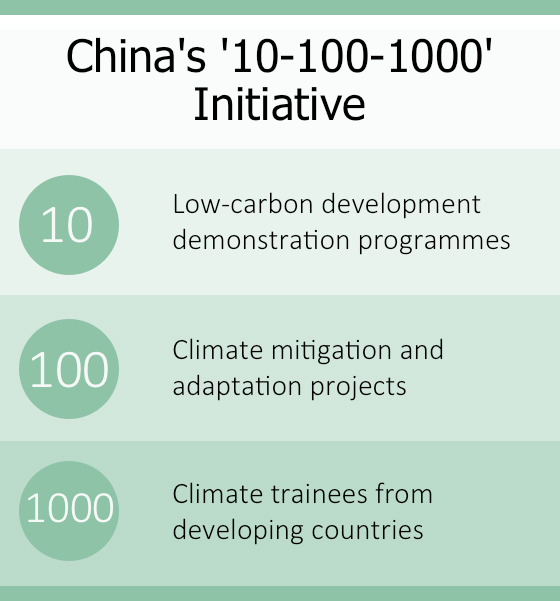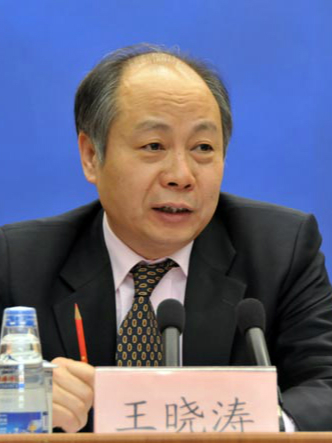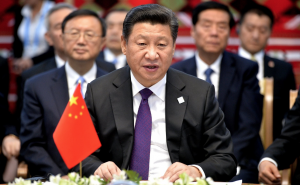One of the most closely-watched changes to come out of China’s recent ministerial shake-up was the creation in mid-April of the China International Development Cooperation Agency (CIDCA), equivalent to the United States Agency for International Development or the United Kingdom’s Department for International Development – agencies responsible for administering foreign aid and development assistance.
Although this sub-ministerial body does not have an official website yet, it got off to a quick start, announcing on May 16 that China would send emergency humanitarian aid to Kenya in response to severe flooding.
Despite its still undefined make-up and responsibilities, observers are already speculating about how the creation of CIDCA will affect China’s overseas aid, the Belt and Road Initiative, and wider South-South cooperation, including China's climate change foreign aid to other developing countries.
Cooperation on climate
China’s South-South climate cooperation has focused on providing aid to less developed nations commensurate with its position as the world’s largest developing country. The country's overseas aid has had a climate change component for more than a decade and this has expanded over the years.
In 2012 the National Development and Reform Commission (NDRC) announced that funding would be doubled for climate change aid to about US$72 million a year. Subsequently, a project to donate materials to help countries respond to climate change got underway, headed by the NDRC’s Department of Climate Change and funded by the Ministry of Finance. Notably, this included the donation of a meteorological satellite to Ethiopia.
In September 2015, before the Paris climate conference, China stepped up its commitment when Xi Jinping announced a 20 billion yuan (US$3.1 billion) South-South Climate Cooperation Fund. Two months later, in Paris, the government clarified its scope: from 2016 China would fund 10 low-carbon demonstration projects, 100 climate change adaptation and mitigation projects, and 1,000 training places in developing nations (the “10-100-1000” plan).
More recently, the 19th Communist Party of China National Congress work report stressed that China would cooperate internationally on climate change to contribute to and lead in the construction of an international “ecological civilisation”.
China views developed nations as having a responsibility to developing countries, owing to their historical emissions of greenhouse gases. In contrast, China is assisting developing nations out of a sense of climate justice rather than obligation. This has shaped China’s assistance, which is “voluntary” and “supplementary”, and stands separate from that of developed nations, which are channelling climate finance contributions through the Green Climate Fund (GCF), a United Nations fund to help developing nations counter climate change.
Following the decision by President Trump to withdraw the United States from the Paris climate accord, China’s actions have been closely watched.
China’s pledge of 20 billion yuan to the South-South Climate Cooperation Fund was part of the Obama-Xi Joint Statement in 2015 that was made shortly before the Paris talks started. In that statement, the US made an equivalent pledge of US$3 billion to the Green Climate Fund. President Trump has said that the US will not honour the US$2 billion that remains to be paid to the GCF, while China appears commited to carry on with its promised plan.
The shoe doesn’t fit
Providing direct material aid and training is relatively straightforward. However, other elements of the “10-100-1000” plan had to be implemented within a framework that was not fit for purpose. The mismatch prevented plans going ahead as scheduled.
 The first issue was funding. The NDRC is responsible for macro-level planning and has no overseas remit. The Ministry of Finance’s rules require that the NDRC’s South-South climate cooperation spending and procurement take place in China. The “10-100-1000” plan, therefore, had to be designed to fit that requirement, with the 100 mitigation and adaptation projects limited to material donations – and to those goods that could be purchased in China. This affected both the quality and pace of project delivery.
The first issue was funding. The NDRC is responsible for macro-level planning and has no overseas remit. The Ministry of Finance’s rules require that the NDRC’s South-South climate cooperation spending and procurement take place in China. The “10-100-1000” plan, therefore, had to be designed to fit that requirement, with the 100 mitigation and adaptation projects limited to material donations – and to those goods that could be purchased in China. This affected both the quality and pace of project delivery.
Similarly, the 10 low-carbon demonstration projects were originally intended to be industrial zones or residential neighbourhoods in recipient countries, promoting general low-carbon development practices (in planning, management and infrastructure construction). But again, the requirement for procurement in China hindered progress.
Then there were personnel issues. As the only option was to buy goods at home, the NDRC’s Department of Climate Change needed to quickly develop new competences to ensure quality procurement: tendering processes, technical workflows, product standards, financial reporting, working across languages, negotiating, and assessing the needs of different nations. This was clearly too much to expect from a department previously responsible for climate change policy.
The final issue was communication. The domestic role of the NDRC means it has no direct links with other countries and so no way to directly communicate with recipient nations.
While the Ministry of Foreign Affairs traditionally handles overseas relationships, China’s expanding links with the rest of the world mean that the Ministry’s embassies abroad were already stretched. Although willing to help implement the plan, they lacked sufficient capacity to do so.
Faced with these constraints, those in charge had to come up with alternative approaches. For example, in August 2016 international non-governmental organisation Oxfam used its expertise to help the Department of Climate Change tour south-east Asia to assess the needs of developing countries. This helped to refine the “10-100-1000” plan and work around the department’s lack of international links.
The Department of Climate Change and the UN Development Programme then held a “matchmaking” meeting to connect the needs of developing nations with types of support that China could provide.
In March 2017, China donated clean cooking stoves and domestic solar power systems to Myanmar, with project delivery entrusted to the Global Environmental Institute, a Chinese non-governmental organisation. These moves were all unprecedented.
Opportunities post-reshuffle
The reorganisation of State Council structures, announced at China’s Lianghui (Twin Sessions) in March of this year, brought seismic changes for climate and environmental governance, with responsibility for climate change reassigned from NDRC to the new Ministry for Ecology and Environment (MEE), which was formally established on April 16. Two days later, CIDCA was created, taking overseas aid responsibilities from the commerce, foreign affairs and finance ministries.
Future South-South climate cooperation is likely to take place within a joint MEE-CIDCA framework. This will help to resolve issues with funding, personnel and international links.
 CIDCA is run by former NDRC deputy chair Wang Xiaotao (pictured). On April 23, Zhou Liujun, former head of the Ministry of Commerce’s Department of Outward Investment and Economic Cooperation, and Deng Boqing, former ambassador to countries including Nigeria, were appointed as vice-directors. The structuring of the two new bodies should be completed by the end of June.
CIDCA is run by former NDRC deputy chair Wang Xiaotao (pictured). On April 23, Zhou Liujun, former head of the Ministry of Commerce’s Department of Outward Investment and Economic Cooperation, and Deng Boqing, former ambassador to countries including Nigeria, were appointed as vice-directors. The structuring of the two new bodies should be completed by the end of June.
The fact that the top three officials for CIDCA have been drawn from China’s powerful macro-economic planning department, its commerce department, and its foreign affairs apparatus bode well for its ability to coordinate with these ministries.
We can expect that arrangements for the “10-100-1000” plan will be improved once governance structures are clearer. While the changes should not have much impact on the training programme, the 100 adaptation and mitigation projects will be able to deploy a more flexible approach to aid that is not restricted only to material donations.
CIDCA will also benefit from established overseas aid systems moved over from the Ministry of Commerce (including material aid, complete project delivery, technical cooperation and training).
This will mean MEE can more easily make use of CIDCA capabilities when designing South-South climate cooperation projects. Researchers also predict that development attachés may be stationed in Chinese embassies to manage China’s overseas aid. This would solve the lack of international links.
Most eagerly anticipated are the 10 low-carbon demonstration projects.
Although initial work on these projects was hampered, a lot of planning has been done and resources are in place.
The new framework will allow MEE and CIDCA to work together to better combine aid, investment and trade. And the model of government-set standards to guide private investment and create green investment is regarded by some experienced figures as the ideal model for those demonstration projects.
I am sure that when the time is right these projects will take shape in climate-vulnerable countries and be of global value.
Three relationships
It is worth noting that China’s arrangements for South-South climate cooperation were not originally limited to the “10-100-1000” plan.
In 2014, China donated US$6 million to support the UN secretariat’s promotion of South-South climate cooperation. In April that year the funding was used as seed capital for a Southern Climate Partnership Incubator (SCPI) announced by Ban Ki-moon. The SCPI is designed to foster partnerships (both bilateral and multilateral) to allow less developed countries to engage in policy exchange, capacity building, and to have access to technologies and knowledge that facilitate climate action.
Combined with the “10-100-1000” plan, China’s use of UN platforms represents a combination of domestic and international approaches to climate change cooperation.
Pushing China’s South-South climate initiative at the UN level has several advantages: it is intrinsically more multilateral, it is not limited by China’s own rigid bureaucratic and financial restrictions, and it takes advantage of the UN’s global reach.
The ministerial shake-up makes efficient implementation of the “10-100-1000” plan possible. Meanwhile, China’s support for South-South climate cooperation under the UN system is growing and starting to attract civil society forces. For example, the Qiaonyu Foundation donated 100 million yuan (US$15.6 million) for South-South climate cooperation, with US$1.5 million going towards running the SCPI.
In January this year the foundation signed an agreement with the United Nations Office for South-South Cooperation launching the Qiao plan, which will use the UN to identify potential recipients of funding.
South-South climate cooperation can be expected to take place between the Chinese government and the UN, across Chinese government departments, and between the government and civil society.
If those three relationships promote and strengthen each other, resulting in projects that meet recipient nation needs while furthering mitigation, adaptation, poverty-relief and environmental protection, then South-South climate cooperation will be successful.
Parts of this article are taken from the author’s new book, From Zero to Hero: China's Transition on Climate Communication and Governance, published April 2018 by the Social Sciences Academic Press.






